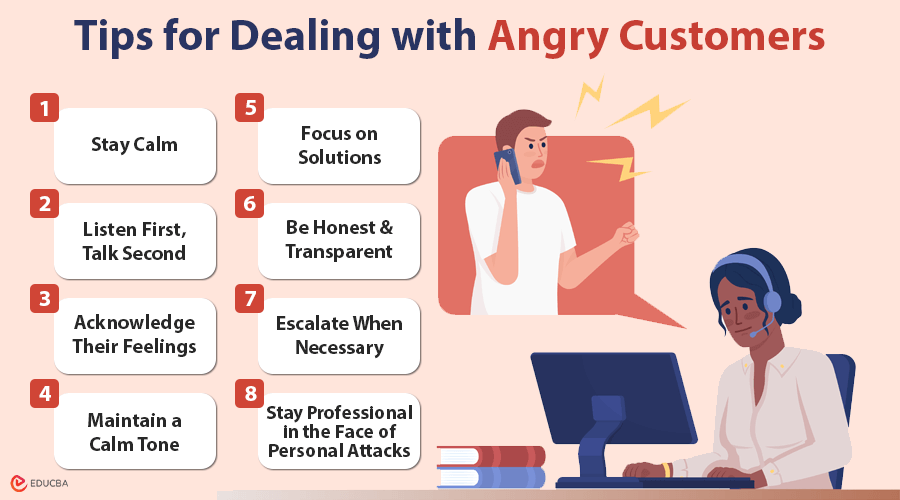
Dealing with Angry Customers
Facing an upset customer is one of the toughest challenges in customer service, especially in call center outsourcing environments where agents often handle interactions remotely. However, with the right approach, you can transform these difficult interactions into opportunities to build loyalty and trust. Here, we will guide you through understanding why customers get angry and how you can handle these situations effectively. Let us dive into practical strategies for dealing with angry customers while maintaining professionalism and empathy.
Why Customers Get Angry?
An angry customer usually feels disappointed by a product, service, or experience. Here are some common reasons customers become frustrated:
- Unmet Expectations: The product did not work as promised, or the service failed to deliver.
- Financial Loss: Feeling they wasted money on something that did not meet their needs.
- Disrespect or Poor Service: A lack of care or attention from customer service can escalate frustration.
- Bad Timing: Sometimes, a customer’s anger is not entirely about your product or service; it might just be the final straw in a bad day.
Ultimately, customers want to feel heard, valued, and treated fairly.
Top 10 Brilliant Tips for Dealing with Angry Customers
Here are some tips for dealing with angry customers:
- Stay Calm: Do not take the anger personally. Remember, the frustration is about the situation, not you.
- Listen First, Talk Second: Allow the customer to vent. Actively listen to their concerns without interrupting.
- Acknowledge Their Feelings: Use empathetic statements like, “I understand why this would be frustrating for you.” This shows you care.
- Maintain a Calm Tone: Speak in a steady, respectful voice. Even if they are upset, your professionalism can de-escalate the tension.
- Focus on Solutions: Ask, “What can I do to make this right?” This shows your dedication to addressing their concern.
- Be Honest and Transparent: If you cannot solve the problem immediately, outline the steps you plan to take to address it.
- Escalate When Necessary: If the situation becomes too heated, involve a supervisor who can bring a fresh perspective.
- Stay Professional in the Face of Personal Attacks: If the customer becomes rude, remain composed. Shift the focus back to solving the issue.
- Offer a Gesture of Goodwill: A discount, refund, or small gift can go a long way in rebuilding trust.
- Follow-up: After resolving the issue, check in to ensure the customer is satisfied. This extra step can turn frustration into loyalty.
Common Mistakes to Avoid
Here are some common mistakes while dealing with angry customers:
- Arguing or Getting Defensive: This will only escalate the situation.
- Interrupting the Customer: Let them fully express their frustration before responding.
- Using Negative Body Language: Avoid crossing your arms, rolling your eyes, or showing impatience.
- Failing to Apologize: A sincere apology shows empathy, even if the issue was not your fault.
How to De-escalate a Heated Conversation?
- Let Them Vent: Do not interrupt; let them get everything off their chest.
- Validate Their Feelings: Use phrases like, “I completely understand how this could be upsetting.”
- Apologize Genuinely: A heartfelt apology goes a long way, even if it is not your fault.
- Focus on Solutions: Shift the conversation toward resolving the issue.
- Stay Open: Use positive body language eye contact, and avoid defensive postures.
Why Helping Angry Customers Matter?
- Word of Mouth is Powerful: A single bad experience can result in negative reviews and lost customers.
- Customer Retention is Cheaper: Solving problems helps keep customers, which is more affordable than gaining new ones.
- Turning Critics into Advocates: Successfully addressing complaints can turn unhappy customers into loyal fans.
- Valuable Feedback: Complaints often highlight areas for improvement in your products or services.
Final Thoughts
Dealing with angry customers is an art that requires patience, empathy, and professionalism. By staying calm, actively listening, and focusing on solutions, you can turn even the most difficult interactions into opportunities to build trust and loyalty. Remember, each upset customer is a chance to demonstrate your company’s commitment to exceptional service. Use these tips to resolve issues and create satisfied, loyal customers.
Frequently Asked Questions (FAQs)
Q1. What if the customer refuses to calm down?
Answer: If needed, bring in a manager or supervisor. If the customer becomes aggressive, prioritize your safety and mental health.
Q2. What should I do if I do not know the answer to the customer’s issue?
Answer: If you are unsure about resolving a customer’s issue, admitting that you do not know is okay. Offer to find the answer or escalate the issue to someone who can help. Always follow up with the customer to ensure you address their problem.
Q3. How should I follow up after resolving an angry customer’s issue?
Answer: After resolving the issue, following up with the customer is helpful to ensure their satisfaction with the resolution. Depending on your business, you can follow up by phone, email, or message. This shows you care about their experience and commit to improving their satisfaction.
Q4. What should I do if the customer is not satisfied with the resolution?
Answer: If customers remain unsatisfied, acknowledge their frustration and re-evaluate the situation. Provide other solutions or take the issue to a higher authority.
Recommended Articles
We hope this article on Dealing with Angry Customers is effective. Check out these recommended articles for more strategies and insights on providing exceptional customer service.
